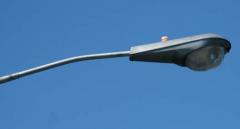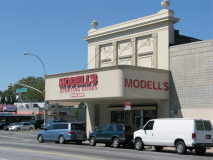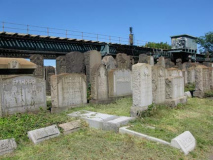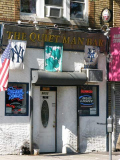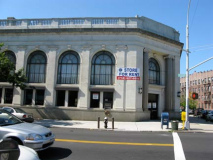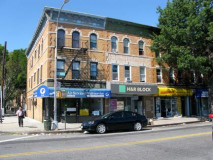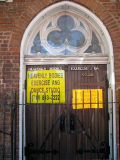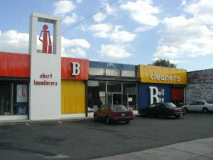Because of its proximity to John F. Kennedy International Airport, I had always thought Ozone Park’s name had something to do with air travel, since the ozone layer is high in earth’s atmosphere. I couldn’t have been more wrong. When developers Benjamin Hitchcock and Charles Denton built lots of small houses immediately south of Woodhaven in the 1870s, they adopted a name for the area that they thought would be evocative of fresh air and cool breezes far away from congested Manhattan, and that’s the connotation the word “ozone” had back then.
Till now, my experience with southern Queens has been relatively sparse, even though Ozone Park was the first Queens neighborhood I encountered when cycling into the borough from Bay Ridge, where I lived until 1993. This page is the beginning of my efforts in reconnecting.
That means that I’ll have to touch on such diverse personalities as Jack Kerouac, Bernadette Peters, and Cyndi Lauper, who have all lived in Ozone Park, at another time. Besides the formerly clean breezes, the chief attraction in Ozone Park almost from the beginning was the horse races, with both the Centreville and Union Race tracks in the area beginning in the 1880s, with NYC’s most well-known course, Aqueduct, first built in 1894 and named for a watercourse that brought water to Long Island from Ridgewood Reservoir in Highland Park (North and South Conduit Avenues also remember it). Races are run at Aqueduct from late October through early May. It is home to the Wood Memorial Stakes, a major race in the runup to the Kentucky Derby, each April.
In September 2008 I traversed Liberty Avenue from Lefferts Boulevard west to the Brooklyn border, then back on 101st Avenue. This tour isn’t meant to be a full survey of Ozone Park — I didn’t venture south toward the track and the Cross Bay Boulevard area — but rather a brief snapshot of a specific area…
Marlowe Jewelers (near 116th Street) and Domenic Dry Cleaners (near 105th). Both signs feature cut-out custom lettering, and identifiable fonts: the “Jewelry” on the roll up gate is in Cooper Black while “Dry Cleaner” is in the ever-popular Helvetica Bold.
Oxford Bakery, or Bake Shop, 104th and Liberty Avenue. So named because the nearby 104th Street station is still subtitled Oxford Avenue, the former name of the street. Queens has five major el lines, and each one preserves former street names in its stations. For example, on the Liberty Avenue el, we have Greenwood Avenue (111th Street), Oxford (104th), Boyd Avenue (88th Street). Though the official MTA map refuses to acknowledge them anymore, the signs are still there; indeed, each time the signs are updated, the names are, too. The bakery has been here for over 90 years — meaning that it was here when this was Oxford Avenue.
Couldn’t resist a leftover Westinghouse OV-25 (second series, with the photocontrol at the rear) on 101st just north of Liberty. The OV-25s started showing up around 1959-1960 and throughout the 1960s, staged an epic battle with the General Electric M400s (see below) for lamppost supremacy on the streets of NYC. I think the GEs edged out the Westies, but each had their strongholds. (For me, an obsessive, I always noted a member of the enemy camp in the other’s.)
Mercury Falling (the lamppost battle of the 1960s)
It’s a double overpass at Liberty Avenue as the el must rise above the Long Island Rail Road Rockaway Branch between 100th and 99th Streets. As you can see from the weed trees on the trackbed, this section of the LIRR is out of business; the Rockaway, which connects to the LIRR main line in Rego Park, has not had passenger service since June 8, 1962. However, off in the distance you can see a ramp from the Liberty Avenue el trailing southeast. It was constructed in the early 1950s when IND service was extended from this el to the Rockaway Branch, crossing Jamaica Bay to the Rockaway peninsula, where it wyes into two terminals at Mott Avenue in the east and Rockaway Park in the west.
FNY and some intrepid urban explorers marched the old Rockaway Branch in 1999.
Above: 96th Street. Dutch immigrant Peter Christiaän Richard opened his first hardware store in Bensonhurst, Brooklyn, in 1909 and over the years, the family expanded their operations to include electric appliances. Along with Best Buy and Radio Shack PC Richard is now one of NYC’s leading electronics chains. Here we see a faded ad for the company dating to mid-century.
RIGHT: nearby, Liberty Avenue.
The old Cross Bay Theatre, 94-11 Rockaway Boulevard, at the junction of two of Queens’ busiest, pedal to the metal thoroughfares: Rockaway Boulevard, which connects Brooklyn with the Five Towns of Nassau County, and Woodhaven Boulevard, which roars from Queens Center on Queens Boulevard across Jamaica Bay to the peninsula. Here at Liberty Avenue, it changes monikers from Woodhaven to Cross Bay Boulevard.
The theatre itself opened in December 1924 and remained open as a 3-screener until June 23, 2005. Like the Dyker on 86th Street in Bay Ridge, it became a Modells Sporting Goods store.
Here’s a great Cross Bay story from cinematreasures:
It was a summer Saturday 1962, I was six years old, and my sister was eight. My mother had to go on an errand, and she decided to let us spend the day at The UA Crossbay. The main feature was The Longest Day. Not exactly kiddie fare. My mom gave my sister the money and gave her strict instructions to wait for her on the bench, which then existed on the triangle in front of the theatre. The bench faced west towards Woodhaven Blvd. It was a plan. It should have worked. It would have gotten her in trouble these days, but back in 1962, life was different.
My sister was wearing shorts. Back in those days, the UA Crossbay, and a lot of other theatres had a modesty rule against ladies wearing shorts to their establishments. I guess that it is the same kind of rule that they use in Afghanistan where women may only wear those birkas in public.
The manager in his suit and tie saw my sister in her shorts and refused admittance to her on the basis of her attire. I said that if my sister can’t go in, I am not going in. We held hands and crossed Liberty Avenue to the bench on the triangle. We sat there until everyone had entered the theatre. The show must have started. I guess that the manager felt like a real fool enforcing that no shorts rule against an eight year old and her six-year-old brother. He sheepishly ambled across Liberty Avenue and told us that it was OK; we could come in and see the movie. Before I could say “YIPEE!” and race across Liberty Avenue, my sister dug her heels in and firmly told the manager that she was staying right there and waiting for her mother. She did not want to see their movie. The manager slunk away like the evil minded little jerk that he was.
We sat there watching cars zoom up and down Cross Bay/Woodhaven, Liberty/Rockaway for at least six hours. Barely talking. I never counted so many cars before. It was among the worst days of my little life. My mom was angry with the manager, but proud of us for sitting like little statues for such a long time. She never did anything like that again.
There is a distinct tinge of sadness now almost half a century later that the UA Crossbay is now gone, I have moved far away to the wilds of central New Jersey, the manager of public morals must have gone to his just reward, and the world is such a different place.
West of Woodhaven/Rockaway Boulevards, Liberty Avenue becomes much sleepier and becomes that NYC rarity, a residential-dominated street under an el. There are storefronts here and there, but it’s very quiet here and was even on a summer Saturday. Above right: The MTA acknowledges Boyd Avenue about 90 years after it became 88th Street.
The reason Liberty is quiet here becomes apparent…
Acacia Cemetery
Between 80th and 84th Streets and Liberty and Pitkin Avenues we find three Jewish cemeteries occupying an uneven rhomboid: from east to west they are Acacia Cemetery, Bayside Cemetery and Mokom Shalom Cemetery. As we can see from an overhead view, Acacia, furthest east and shown above, is in the best shape and is still active. Bayside Cemetery, which has existed here since before the Civil War and has several veterans of the conflict buried within, is overgrown with weeds and weed trees and is in tough shape.
Bayside Cemetery, seen through the fence from Liberty Avenue. The barbed wire is easily breachable by vandals, who have turned over headstones, invaded crypts and scrawled graffiti.
Along Bayside Cemetery, Liberty Avenue has a small-town aspect.
At Liberty and 78th we see a remaining General Electric M400 luminaire; lurking under els we often see formerly common varieties of street lighting. ABOVE: Liberty Avenue is free! Of the el, that is, at it crosses west into Brooklyn. According to lore, Liberty Avenue is so named not for any great patriotism on the part of the namers, but because it was free of tolls, unlike Jamaica Avenue or Rockaway Boulevard (formerly Rockaway Plank Road) which had them until the end of the 19th Century.
The Liberty Avenue El is actually the last surviving piece of the Fulton Street el. After the majority of the Fulton el was lost in the 1940s, city engineers decided to link the new IND line under Pitkin Avenue by ramping it here and joining it with the el’s eastern section. It was a brilliant move — the MTA has no such imagination or monetary wherewithal today — and opened the subways to Ozone Park and ultimately the Rockaway peninsula.
101
Here I turned back east on 101st Avenue, which angles northeast from Liberty Avenue at Forbell. One block of 101st Avenue is entirely in Brooklyn, the only Queens-numbered avenue that does this. Before it was called 101st Avenue it was Jerome Avenue and earlier than that, Broadway. Neighboring 102nd Avenue between 81st and 88th Streets used to be Shoe and Leather Street; I’d like to see that old street sign.
You will also often find outmoded lamppost designs in parking lots. This number on 101st and 76th Street appears to be from the very early 1960s. Can’t identify the luminaire, but it has a green-white mercury bulb, could be a Westinghouse.
TOP: corner, 101st and 75th
Christ Evangelical Lutheran Church, 101st and 86th Street (also called Lutheran Place). The cornerstone, marked 1884-1917, denotes the origin of the congregation and the date the present church was built.
On the side door on 86th Street, we find a clever blend of the spiritual and the secular.
But the way of all flesh hovers nearby.
Just across the street at 101st and 86th I spotted this sign saying “Woodhaven Poultry Market.” The building still houses a deli. We’re on that nebulous line that separates Woodhaven and Ozone Park, which I’ve always placed between Atlantic and Liberty Avenues.
Bhuvaneshwar Mandir temple, 8606 101st Avenue.
Bhuvaneshvari is associated and identified with the earth, the creation in general, and the underlying energy that brings it to be and pervades it. She embodies the characteristic dynamics and constituents that make up the world and that lend creation its distinctive character.
The legend behind her origin says that in the beginning the sun appeared in the heavens. The rishis (sages) offered soma (a sacred plant) so that the world might be created. The sun then created the three worlds (lokas or bhuvanas). At that time Shodashi (Tripura-sundari) was the main power, or shakti, through whom Surya (sun) created the worlds. Having created the worlds, or having empowered the sun to do so, the goddess assumed an appropriate form and pervaded and directed the triple world. In this form she became known as Bhuvaneshvari, “mistress of the world.” It is further said that Bhuvaneshvari remains unmanifest until the world is created. That is, Bhuvaneshvari is particularly associated with the visible, created world. Exotic India Art
St. Stanislaus School, 101st Avenue and 90th Street. A pleasant yellow-brick building with distinctive arched windows on the top floor.
American Legion Post 632. This looks like it could have been a small theatre building. The post is named for Corporal John Ruoff, the first soldier from Ozone Park to be killed in World War I. The intersection of Cross Bay and Rockaway Boulevards across from the Cross Bay Theatre, seen above, is also named for him.
Quaint steepled church at 97-45 92nd Street housing at present the New Life Apostolic Church. I didn’t see a cornerstone, but the church building could be about a century old.
United Presbyterian Church of Ozone Park, 101st Avenue and 94th Street. Oddly enough, an area’s churches, liquor stores, beauty parlors, and drugstores preserve a neighborhood’s old character as well as any other institutions. Retail establishments emphasize the trendy and the new, making them less likely to retain any artifacts, or look the same as they did decades ago.
Vicki’s For Good Grooming, the corner of 101st Avenue and 92nd. Betsy Ross would get her perm done here.
94th Street and 101st Avenue. This is another of one of Woodhaven/Ozone Park’s marvelous brick structures that have been compromised by modern renovations. This building may once have had a tower or cupola on the corner.
Bank building for rent, corner 101st Street and 95th Street. 95th, originally called Flushing Avenue, is a curving route that was one of the first north-south roads in the area, predating Woodhaven Boulevard.
Quiet Man Bar, 96-03 101st Avenue. The name of the pub may perplex some Ozone Parkers, but most of its patrons are aware that it is named for The Quiet Man, a 1952 John Ford movie, starring John Wayne as an American former boxer who retires to Ireland seeking his roots in that country.
RIGHT: the shuttered Eichler’s Pharmacy, 97th Street
A pair of signs at 101st Avenue and 97th Street are in conflict about where you could obtain some skin-scrawling. I followed the larger sign on the right to 97-18 97th (below right), but a tattoo parlor wasn’t in immediate evidence.
101st Avenue and 98th Street. Another corner building that doesn’t look quite the same as it must have when first built. RIGHT: LIRR Rockaway branch overpass between 99th and 100th Streets.
This corner was the location of the Bergin Hunt and Fish Club, the Ozone Park headquarters of Gambino crime family leader John Gotti:
Ozone Park resident Thomas Giseppi stood across the street from the Bergin Hunt and Fish Club on June 9, looking at Gotti’s one-time hang-out and reminiscing about what the mob boss did for their neighborhood. Giseppi said, “He was a great man. I would see him around. He always smiled and said ‘hi.’ He was clean cut, and always a gentleman. He made this neighborhood great. Everyone had respect for each other. And he loved this neighborhood. Anything we heard about in the news, he didn’t bring it here.” Queens Tribune
——————————————–
It was a dark time on 85th Street in Howard Beach in March 1980 when 12-year-old Frankie Gotti, son of the then-mob captain, was killed in a traffic accident while riding a dirt bike…in a story that is a staple of mob lore, John Favara, 51, the neighbor who was driving the car that struck Frank, disappeared and was never found. Police said the murder was carried out by Gambino gangsters.
This week [January 2009], tales of Favara’s demise were resurrected as prosecutors alleged in court papers that his remains were dissolved in acid by Charles Carneglia, a mob associate of the Dapper Don. Newsday
Change at Ozone Park
The remains of the LIRR Ozone Park station, elevated here in 1930. This was once an important LIRR transfer station:
Herbert George, whose book Change At Ozone Park notes the various LIRR lines that extended to the Rockaway Peninsula, describes the Ozone Park station:
Ozone Park station was set up to enable passengers from Pennsylvania Station and Flatbush Avenue to reach the Rockaway Park area or Far Rockaway section simply by changing trains (“Change At Ozone Park!”) At certain times, the trains would stack end-to-end, and passengers would transfer back and forth on the platform. Of course, operation in the reverse direction also occurred. Due to street restrictions below, which limited the right-of-way width above, platforms were on the outside of the four track right-of-way, making an across-the-platform exchange impossible. To accommodate this, the platforms were made exceptionally long, so that non-rush hour length MU trains could stack end-to-end and allow passengers to transfer. A set of crossovers from the outside tracks to the inner tracks were at the east end of the station, to permit trains stopping at Ozone Park to run express after the station stop, or to perform the reverse move.
D & D Food, 101st Street and 101st Avenue. The art on the side wall may look odd for anyone unaware of the legend surrounding the founding of the city of Rome:
According to Roman mythology, the founders of Rome were Romulus and Remus. The twin-brothers were the supposed sons of the god Mars and the priestess Rhea Silvia. The story begins with the deposition of Numitor (their grandfather and king of the ancient Italian city of Alba Longa), by his brother Amulius. Numitor’s daughter, Rhea Silvia, was made a Vestal Virgin by Amulius – which meant that she was made a priestess of the godess Vesta and therefore forbidden to marry. However, the god Mars came to her in her temple and of him she conceived her two sons, Romulus and Remus.
As soon as they were born, her husband abandoned them in a remote location. This practice was a form of quasi-infanticide tolerated in many ancient cultures, including the Roman and Greek, when children were unwanted. They were unwanted because Amulius, fearing that the boys would grow up to overthrow him, had them placed in a trough and thrown into the River Tiber. At that time the river was in flood, and when the waters fell, the trough, still containing the two boys, came ashore. They were found by a she-wolf, who instead of killing them, looked after them and fed them with her milk; the she-wolf was helped by a woodpecker who brought them food too. Interesting enough both these animals were sacred to Mars. UNRV History
On opposite corners, 101st and 101st presents a pair of almost exquisite forms of 21st Century architectural junk.
I sometimes read like some kind of ‘elitist fop’ as Mary Beth mixed-metaphorically puts it (about someone else, not me), when I complain about buildings I don’t like, and I realize it’s a matter of taste. It’s hard for me to fathom, though, that architectural schools turn out people who feel that the soultion to building cheaper housing (and I realize some housing has to be more affordable that others) is to build them all the same…blond-bricked, rusty fire-escaped, lawn-free, and soul-free.
There’s nothing architecturally inferior about the St. Mary Gate of Heaven Church at 103rd Street, which looms over the neighborhood. The name is merely an honorific of the Blessed Virgin Mary, mother of Christ. Though the parish was founded in 1904 I am not sure if this is the original church edifice.
The wonderfully named Hall of Justice on 101st and 107th is, or was, a comic book store.
I loved the Sovereign Bank building design on Lefferts Blvd. and 101st Avenue. It’s minimalist, boxy, glassy, and makes great use of two primary colors, yellow and red. When I was a kid, my Legos were primarily red and white, which is why I exulted when sometime in the late 60s, Lego added more colors to the sets. But the original red and white taught me discipline: hold back with color; use it sparingly.
The design is much like that of Bell Boy Cleaners on Beach 20th Street in Far Rockaway, another building I worship. It’s a 1950s go-go drive-in esthetic that I have a soft spot for.
photographed September 2008; page completed January 11, 2009
erpietri@earthlink.net
©2009








